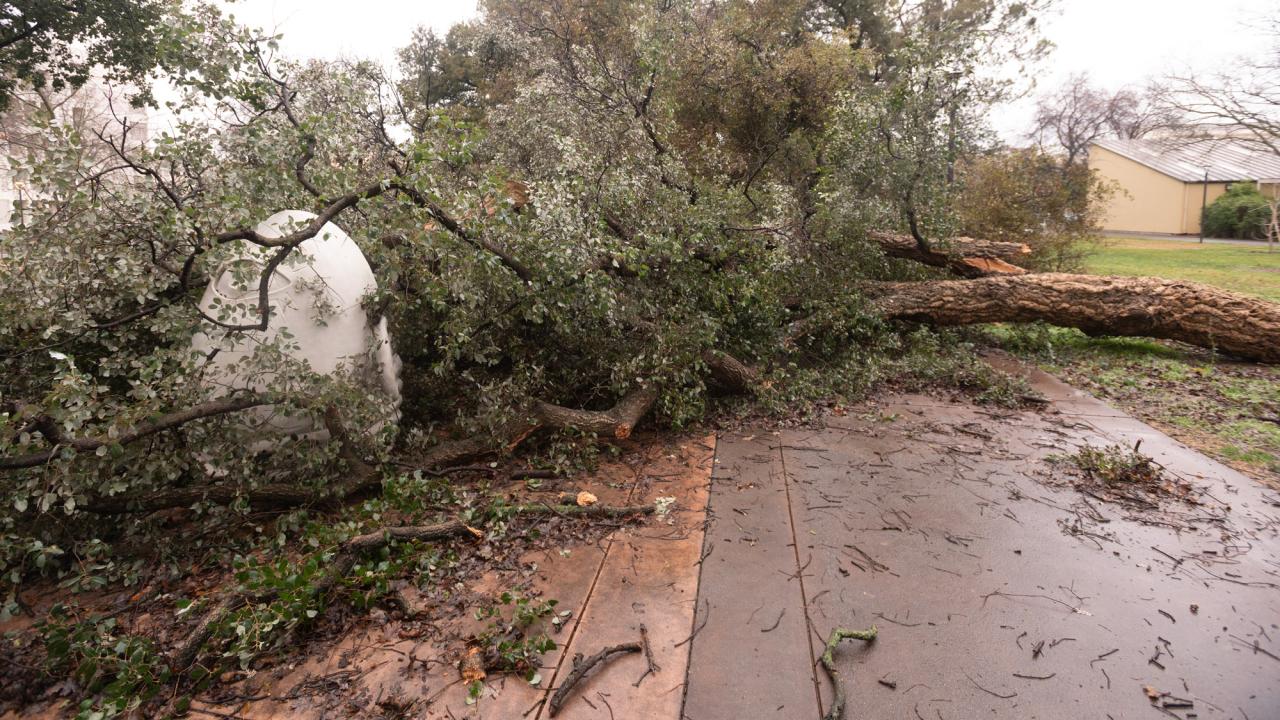Quick Summary
- The Arboretum seeks to stave off future tree losses
- Adaptation plan aims for more resilient urban forest
- “To create a legacy for the next 100 years and beyond!”
Updated noon Jan. 5: Reports this morning indicate the Davis campus lost two trees in last night’s storm — a hackberry on the north side of Wickson Hall and a locust on the north side of Hoagland Hall — significantly fewer than the toll from the New Year’s Eve storm. Lucas Griffith, director of campus planning and environmental stewardship, noted that the wind Dec. 31 blew from the east (all the toppled trees fell to the west). Contrast that to Jan. 4, when the campus experienced, as it generally does, wind from the south. "Our trees are more used to that wind,” he said.
Originally published Jan. 4: The Davis campus was braced for the arrival today of a blast of wind and rain like the New Year’s Eve storm that brought down 25 trees, including one that left a hole in the side of Kemper Hall, in the engineering district, and another that landed atop an Egghead sculpture.
ROAD CONDITIONS
The National Weather Service urges: “Turn Around, Don’t Drown” — It is NEVER safe to drive or walk into floodwaters.
Campus emergency officials told supervisors and managers in a memo Tuesday evening to advise their employees that they can work from home today and Thursday (Jan. 4 and 5) if they can perform their jobs remotely. If you are coming to campus, the officials urged, do not park your vehicles under trees, and do not walk under trees
Along with the rain today, the National Weather Service predicted southeast winds 10 to 15 mph with gusts to around 35 mph this morning, increasing through the day to 25 to 45 mph with gusts to around 60 mph after midnight. More of the same is in the forecast for Thursday, with gusts up to 50 mph in the morning.
Wind speed in the New Year’s Eve storm ranged from 33 to 41 mph with gusts up to 55 mph. Precipitation that day totaled nearly three-quarters of an inch.

Campus crews worked Sunday (New Year’s Day) and Monday (the university holiday) clearing roads and paths, before diving back in again Tuesday: bringing down limbs and branches that posed a risk of falling, cleaning up in the Arboretum and around the residence halls, where students are expected to start returning Friday from winter break; and clearing and repairing storm drains.
Adapting to change
Meanwhile, as they assessed the damage from New Year’s Eve, campus planners noted more evidence of the importance of their ongoing efforts to build a more resilient urban forest in the face of climate change and extreme weather events.
“Our urban forest experts are documenting what happened in this storm,” said Kathleen Socolofsky, assistant vice chancellor and director of the Arboretum and Public Garden. “They will use this information to learn more about how urban forest trees respond to extreme weather events, and study how we can adapt.”

In fact, the Arboretum and Public Garden has already embarked on a Living Landscape Adaptation Plan, or LLAP, to address the likely impacts of climate change, dwindling water supplies, aging plant populations and plant health threats.
The LLAP includes the Campus Tree Renewal Program, which involves tree removals and plantings, community engagement, “and, at the end of the day, creating a legacy of campus trees for the next 100 years and beyond! ”
Toward that end, the Arboretum and Public Garden is conducting research by way of its Texas Tree Trials, in which more than 200 trees from the hot and arid climate of Texas have been planted on campus, to see if any of the 40 species can thrive here despite increasing temperatures and extended drought.
Mapping the damage
Lucas Griffith, director of campus planning and environmental stewardship, said the New Year’s Eve storm swept through an area between Hutchison Drive on the north and the Arboretum Waterway on the south.

Three cork oaks came down on the Mrak Mall, between Mrak Hall and Shields Library; the canopy of one of those trees landed atop Eye on Mrak , one of a series of Robert Arneson Egghead sculptures on campus. “The Egghead seems to have avoided significant damage, perhaps due to the natural strength provided by the egg shape,” Griffith said. “Nature is smart.”
The Jan Shrem and Maria Manetti Shrem Museum of Art, caretaker of the campus’s Egghead series, is working with its campus partners to clear the downed tree in the coming days. A complete assessment of possible damage is likely to take some time to complete.
Tale of the trees
Evergreen trees accounted for all but two of the downed trees in the New Year’s Eve storm, with experts noting that such trees, because they do not lose their leaves, catch the wind like a sail.

A eucalyptus crashed through the north wall of Kemper Hall, leaving an 8-foot-wide hole. Facilities Management covered the hole with plywood for protection from the next storm, and while waiting for supplies to repair the wall.
Other trees, as they came down, brushed the sides of a couple of buildings, including Regan Hall in the Primero Grove Residential Area.

Emily Griswold, director of GATEways Horticulture and Teaching Gardens for the Arboretum and Public Garden, expressed sadness at the loss of a Guadalupe cypress, Cupressus guadalupensis, dating back to 1936.
The Arboretum and Public Garden plans to take cuttings of the tree to hopefully propagate one or more of the species that is native to only one place in the world: Guadalupe Island off Baja California.
Katie Hetrick, senior communication manager on the Finance, Operations and Administration communications team, contributed to this report.
Media Resources
Dateline Staff: Dave Jones, editor, 530-752-6556, dateline@ucdavis.edu; Cody Kitaura, News and Media Relations specialist, 530-752-1932, kitaura@ucdavis.edu.
